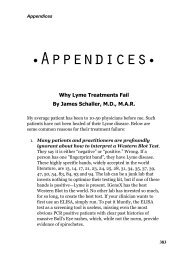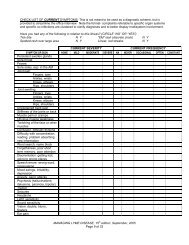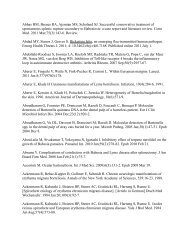Download Here - James L. Schaller, M.D., M.A.R., P.C
Download Here - James L. Schaller, M.D., M.A.R., P.C
Download Here - James L. Schaller, M.D., M.A.R., P.C
Create successful ePaper yourself
Turn your PDF publications into a flip-book with our unique Google optimized e-Paper software.
Environmentally Friendly Mold Remediation Techniques That Significantly Reduce Childhood AsthmaNote: The EPA Table 1 states that fiberglass insulation (in walls orattics) that becomes wet must be discarded. This is not always thecase. If the fiberglass insulation is blown in insulation, it will lose itsinsulation ability (become packed down) if it gets wet. In such a caseit should be replaced. Rolled in attic or wall insulation on the otherhand that gets wet does NOT need to be replaced. However any wetwalls that have insulation inside will almost never dry before moldforms.All walls that have interior insulation and get wet must be physicallyopened to allow them to dry and to check for mold. Do NOT rely onmoisture meters or advice from water damage "experts" that may stateotherwise.Party walls (drywall walls between units) are always insulated andusually have multiple layers of drywall making up a firewall barrierbetween units. Party walls that get wet need to be opened to allowthem to dry. The drywall "sandwich" and the insulated cavity need tobe physically inspected for mold and replaced or cleaned as appropriate.If there is mold growth on paper faced insulation, the insulation mustbe replaced with new.Semi-porous materials that have surface growth and arestructurally sound. Examples include wood furniture or woodstructural components, wood baseboard, protected composite andengineered wood products, and some resilient floor coverings. Suchitems may be salvaged if they are structurally sound and can be keptdry in the future. Cleaning and remediation steps include one or moreof the following: HEPA vacuuming followed by damp cleaning withsoap and water; or bleaching if suitable. Most mold remediationcontractors are taught to avoid cleaning wood materials with soap andwater or bleach (wet techniques) and prefer sanding with HEPAvacuuming. This is a truly horrible procedure. Sanding wood notonly releases mold fragments but releases toxic chemicals that are usedin the preparation of pressure treated wood.77











